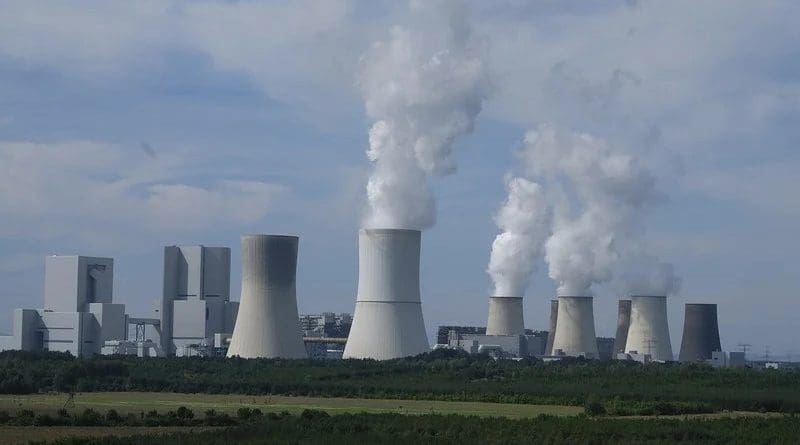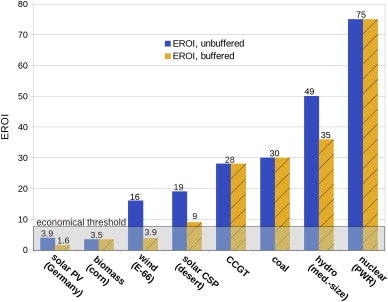If Democrats Really Cared About Climate Change They Would Have Gone Nuclear – OpEd
In an extraordinary coincidence of timing, progressive climate activists discovered last weekend that West Virginia Senator Joe Manchin has ties to the coal industry at the very same moment that he made clear he wouldn’t support their legislation. The novelist Don Winslow created a powerful Twitter video showing links between to the coal industry and Manchin’s wife, son, and daughter. It has gone viral.
In truth, Manchin’s ties to the coal industry have been a matter of public record for decades, and he has been telling Democrats publicly and privately for months that he opposed the so-called Clean Energy Performance Program. But in order to gin up outrage from Democrats, progressives are acting shocked to learn not only that Manchin has ties to one of his state’s largest industries, but also that he opposed The Program.
In truth, few in Washington thought Manchin would change his mind about The Program, in part because it was so badly written, and extreme. The Program was authored and championed by a Canadian political scientist, Leah Stokes, who has no experience regulating electric utilities and who achieved her position by writing a book attacking electric utilities for modestly resisting efforts to make the US electrical grid more reliant on weather-dependent energy sources, which contributed to blackouts in California and Texas.
I have spent the last decade advocating for the preservation and expansion of nuclear energy, in part to address climate change, and believe we need a national strategy to do so. Nuclear energy is first and foremost a national security issue, since nuclear energy programs can be retrofitted to make weapons-grade uranium and plutonium, and the US Congress has inadvertently allowed China and Russia to take over nuclear exports around the world.
But the Clean Energy Performance Program was a badly written subsidy that would have increased electricity prices, blackouts, and US dependence on solar panels made by enslaved Muslims in China. Because of its heavy subsidies for weather-dependent renewables, The Program would not only have resulted in windfall profits for wind and solar developers, it would have locked in natural gas for decades, and likely increased carbon emissions than if the US continues to operate nuclear plants and, for national security, economic, and environmental reasons, expands them.
More work will be required to make that vision a reality, as Democrats made clear. At the moment, the Biden Administration and Senate Democrats led by Sen. Sheldon Whitehouse (D-RI) are considering several alternatives to the failed climate legislation and none include an expansion of nuclear. Some Democrats are pushing the idea of a carbon tax, albeit one that exempts gasoline, the price of which is climbing rapidly. Others are pushing loan guarantees for renewables. Still others are seeking to pay industries to reduce emissions.
Many Democrats are rightly worried that representatives of the Biden Administration will be embarrassed when they show up to climate change talks in Scotland in two weeks empty handed, but many progressive Democrats are unsatisfied with anything short of a radical transformation of our electrical system. Rep. Sean Casten (D-IL), co-chair of the New Democrat Coalition Climate Task Force, told a reporter that tax credit subsidies for solar panels and wind turbines won’t be good enough to replace the Program (CEPP) that Manchin killed.
“As a practical matter, if you pass it with the CEPP you have the most impactful climate policy that has ever been passed by Congress,” said Casten. “And, oh by the way, it’s still not enough. If you pass it without the CEPP, it’s not really a climate bill.”
There is still a way for President Biden and Senate Democrats to salvage their climate change plans, and that’s to pass legislation that would expand nuclear energy from its current 19% today to 30% of electricity by 2030 and 50% by 2050. Such a goal is easily doable, as France, Sweden, Japan, and South Korea have all proven with their expansions of nuclear energy.
Six times over the last two years I urged the Senate and House to pass such a “Green Nuclear Deal,” and found strong support for such a proposal from Republicans and a few Democrats, including Senator Joe Manchin, who described nuclear energy as a way to lift people out of poverty around the world.
“Nuclear power provides about 10 percent of the world’s electricity and prevents approximately two gigatons of carbon from reaching our atmosphere every year,” he said earlier this year. “But about 789 million people around the world still live without electricity. Nuclear energy can be part of delivering that electricity to lift people out of poverty and provide the opportunities that many have become accustomed to.”
The model for the Green Nuclear Deal is the Tennessee Valley Authority (TVA), said Manchin, which involved the construction of large hydroelectric dams, which produced fertilizer, provided cheap electricity for factories, and lifted tens of millions of Americans out of poverty. The first chairman of the U.S. government’s Atomic Energy Commission, David Lilienthal, was the former head of the TVA. He wanted to expand nuclear plants in the same way TVA had expanded hydroelectric dams.
But Lilienthal and other pro-nuclear liberals were attacked by the radical Left, who re-branded themselves first as the “New Left,” and then as “progressives.” By 1970, the radical anti-nuclear Left had taken over the Democratic Party. The label of “progressive” came to mean its opposite. “Progressive,” for the anti-nuclear radical Left, meant returning to a world powered by renewables — a world before nuclear energy, fossil fuels, and the industrial revolution.
Instead of embracing Lilienthal’s vision of a high-energy world, one characterized by universal prosperity and human flourishing, “progressives” sought to return to a world characterized by agrarian poverty and feudal inequality. “Progressives” then proceeded to spend 50 years convincing elites and much of the public that renewables not nuclear represented the future.
Manchin is one of the last old school New Deal Democrats in Congress. Sen. Whitehouse and Rep. Casten are progressive Democrats who believe in renewables. It’s not strictly ideological. Casten, for example, comes out of the renewable energy industry, only entering politics after being repeatedly sued by investors for alleged financial misconduct.
But where Casten and Whitehouse favor subsidies for renewable energy companies, which shield companies from accountability to taxpayers or ratepayers when blackouts result, Manchin favors the TVA model of directly providing electricity to the people.
“The Tennessee Valley Authority,” Manchin said, “is a model that can inform our efforts both domestically and abroad. Russia and China have made a strategic effort to supplant our nuclear leadership over recent years. We must push back. With the necessary policy and funding we can maintain our nuclear supply chain, create high-paying manufacturing jobs, and reassert that U.S. leadership.”
Progressive renewable energy advocates insist that a Green Nuclear Deal is unrealistic, but Britain yesterday announced that it was putting nuclear energy at the heart of its climate agenda, in part for the reasons Manchin mentioned: energy independence and to compete with China.
Last year I coauthored an oped for Britain’s leading conservative newspaper, The Telegraph, with the conservative British environmental activist, Christopher Barnard, titled, “We must take on Russia and China’s energy dominance by going big on nuclear power.” The oped had an impact. Just a few weeks ago the British removed the Chinese government as co-financer of a new nuclear plant.
Financial ties to industries powerful in one’s home state always matter, but the real reason Manchin is pro-nuclear and skeptical of renewables is because the former actually lifts people out of poverty while the latter don’t provide enough energy to sustain our high-energy societies. Fossil fuels made the industrial revolution possible because renewables didn’t provide enough energy.
Renewables are today parasitical on society because they return less than half as much energy as our high-energy societies require to function, while hydro electric dams and nuclear power plants provide three to seven times more energy. This “energy returned on energy invested” (EROEI) calculation is helpful since it doesn’t rely on the financial manipulations renewable industry spokespersons engage in while demanding heavy subsidies.
“Without new construction or the preservation of the existing nuclear fleet in the U.S., achieving a sustainable energy system will be more challenging and expensive,” said Manchin. “Every year in the U.S., nuclear-generated electricity prevents more than 506 million metric tons of carbon dioxide from entering our atmosphere. If we are serious about meeting our climate goals without sacrificing reliability, we must protect our existing fleet. Why then is the U.S. fleet decreasing and why are we taking them offline?”
In his support for nuclear, Manchin shows he cares about climate change while his Democratic colleagues demonstrate, in their unwillingness to consider a Green Nuclear Deal, even at the cost of embarrassing President Biden when his team shows up to Scotland in two weeks, that they really don’t.



Manchin, as above quoted: “Every year in the U.S., nuclear-generated electricity prevents more than 506 million metric tons of carbon dioxide from entering our atmosphere …”
No mention of what it produces instead: nuclear waste. Fun fact about that: when power reactors turn a cubic metre of uranium dioxide into a cubic metre of high-level nuclear waste, the governments that allow this lose approximately one cubic metre of **cash**.
That’s if the money were in the form of tightly baled used tens and $20s. With the recent rise in the price of natural gas, the mix might need to be somewhat 20-heavy, with maybe even some $50s.
You might think nuclear power waste has never injured any neighbour of any storage site, ever in the history of the world, and you would be right, but think of the children.
Specifically, the children of civil servants.